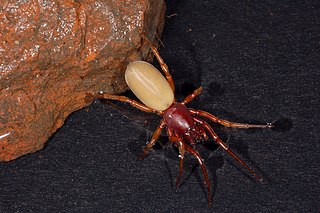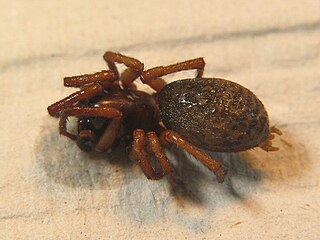
Dysderidae, also known as woodlouse hunters, sowbug-eating spiders, and cell spiders, is a family of araneomorph spiders first described by Carl Ludwig Koch in 1837. They are found primarily in Eurasia, extending into North Africa with very few species occurring in South America. Dysdera crocata is introduced into many regions of the world.

Tegenaria is a genus of fast-running funnel weavers that occupy much of the Northern Hemisphere except for Japan and Indonesia. It was first described by Pierre André Latreille in 1804, though many of its species have been moved elsewhere. The majority of these were moved to Eratigena, including the giant house spider and the hobo spider.

Zodarion is a genus of ant-eating spiders from the family Zodariidae. 169 species from Eurasia, North Africa and North America have been described as of November 2022.

Dysdera is a genus of woodlouse hunting spiders that was first described by Pierre André Latreille in 1804. They originated from Central Asia to Central Europe.

Amaurobius is a genus of tangled nest spiders that was first described by Carl Ludwig Koch in 1837.
Troglohyphantes is a genus of sheet weavers that was first described by G. Joseph in 1881. The genus name is a combination of the Ancient Greek τρώγλη, meaning "cave (dweller)", and -hyphantes, a common ending for linyphiid genera.

Harpactea is a genus in the family Dysderidae. Harpactea is a replacement name published by W. S. Bristowe in 1939 for the unavailable name "Harpactes" published by R. Templeton in 1835, which had already been used for a genus of birds. They are non-web building predators that forage on the ground and on tree trunks at night, mainly in xerothermic forests. During the day, they hide in silk retreats they build under rocks or bark.

Inermocoelotes is a genus of funnel weavers first described by S. V. Ovtchinnikov in 1999.
Dasumia is a genus of woodlouse hunting spiders that was first described by Tamerlan Thorell in 1875.
Dysderocrates is a genus of woodlouse hunting spiders that was first described by Christa L. Deeleman-Reinhold & P. R. Deeleman in 1988.
Folkia is a genus of Balkan woodlouse hunting spiders that was first described by J. Kratochvíl in 1970 as subgenus of Stalagtia, and elevated to genus status in 1974.
Kaemis is a genus of woodlouse hunting spiders that was first described by Christa L. Deeleman-Reinhold in 1993.
Sulcia is a genus of Balkan leptonetids that was first described by J. Kratochvíl in 1938.

Kryptonesticus is a genus of European scaffold web spiders first described by Pavlek & Ribera in 2017, based around the newly described type species Kryptonesticus deelemanae and seven species transferred from genus Nesticus. In 2018, an additional species, K. georgescuae, was described from two female specimens from Romania.

Centromerus is a genus of dwarf spiders that was first described by David B. Hirst in 1886.

Palliduphantes is a genus of dwarf spiders that was first described by Michael I. Saaristo & A. V. Tanasevitch in 2001.










